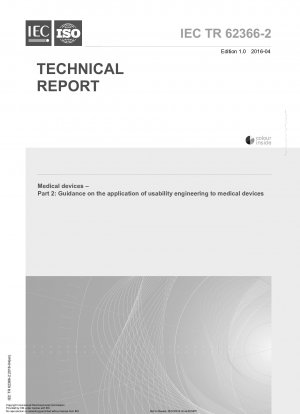IEC TR 62366-2:2016
Medical devices - Part 2: Guidance on the application of usability engineering to medical devices
- Standard No.
- IEC TR 62366-2:2016
- Release Date
- 2016
- Published By
- International Electrotechnical Commission (IEC)
- Latest
- IEC TR 62366-2:2016
- Scope
- This Part of IEC 62366@ which is a Technical Report@ contains background information and provides guidance that addresses specific areas that experience suggests can be helpful for those implementing a USABILITY ENGINEERING (HUMAN FACTORS ENGINEERING) PROCESS both as defined in IEC 62366-1:2015 and as supporting goals other than SAFETY. This technical report is not intended to be used for regulatory purposes. It contains no requirements and only provides guidance and tutorial information. NOTE 1 SAFETY is freedom from unacceptable RISK@ which is described in ISO 14971. Unacceptable RISK can arise from USE ERROR@ which can lead to exposure to direct physical HAZARDS or to loss or degradation of clinical performance. NOTE 2 The PROCESS for a MANUFACTURER to analyse@ specify@ develop and evaluate the USABILITY of a MEDICAL DEVICE@ as it relates to SAFETY is found in IEC 62366-1:2015. This technical report has two main themes: ? information about efficient ways to implement elements required by IEC 62366-1:2015; and ? additional information@ in particular how USABILITY relates to attributes such as TASK EFFICIENCY and USER satisfaction@ which can enhance a MEDICAL DEVICE??S commercial success. This technical report discusses the business benefits of USABILITY ENGINEERING@ the basics of applicable analysis and design techniques@ MEDICAL DEVICE USABILITY EVALUATION approaches@ efficient ways to address USABILITY ENGINEERING project implementation issues (e.g. integration into a quality management system) and provides a list of useful USABILITY ENGINEERING resources. This technical report also can be useful for other healthcare products (e.g. drug packaging and drug LABELLING@ drug-MEDICAL DEVICE combination products and health IT software). Purpose The intent of this technical report is to provide guidance related to: ? the essential elements of a USABILITY ENGINEERING PROCESS as required by IEC 62366-1:2015@ including: ?C USER research techniques@ ?C analysis techniques@ ?C design techniques@ and ?C MEDICAL DEVICE USABILITY EVALUATION approaches (e.g. USABILITY TESTING); ? the planning and implementation of the USABILITY ENGINEERING PROCESS; ? the benefits of applying USABILITY ENGINEERING; and ? improve USER satisfaction. This technical report is intended to be read in conjunction with IEC 62366-1:2015. The intended reader for this technical report includes the people or organisations that are involved with planning@ funding@ managing@ and performing research@ design@ evaluation and regulatory-related activities (i.e. approbation) related to MEDICAL DEVICES@ including@ but not limited to: ? company@ department@ project@ and product managers; ? design and engineering professionals (e.g. human factors engineers@ industrial designers@ technical writers@ information designers@ software developers@ mechanical engineers@ electrical engineers@ packaging engineers); ? medical researchers and other interested clinicians; ? marketers and other business professionals in the MEDICAL DEVICE industry; ? quality or regulatory staffs of MEDICAL DEVICE MANUFACTURERS (for example@ regulatory affairs@ RISK MANAGEMENT or quality management roles); and ? writers of product standards. This technical report is neither intended as the sole source of USABILITY ENGINEERING guidance for MEDICAL DEVICE MANUFACTURERS@ nor a complete substitute for human factors expertise. Rather@ it is intended to provide readers with a general understanding of how to perform USABILITY ENGINEERING in an economic manner. Readers are advised to supplement the knowledge they gain from this report with knowledge acquired from complementary documents including those specific to the MEDICAL DEVICE of interest. A list of useful USABILITY ENGINEERING resources and further readings is provided in Annex A. This report does not address detailed USABILITY ENGINEERING design guidance or requirements@ such as recommendations on the proper size of text on a computer screen@ appropriate ways to arrange a workstation's displays and controls@ or characteristics of an appropriate ALARM SIGNAL. Such information can be found in other documents@ such as [1][2][3][4]1. This technical report does not describe a specific set of USABILITY ENGINEERING activities that suit all design projects. Instead@ it gives guidance for a general USABILITY ENGINEERING PROCESS requiring further shaping and tailoring to suit a given development project's needs. USABILITY ENGINEERING practice varies widely throughout the world and even within specific countries@ companies@ and company units. This variation is partly due to the diversity found among USABILITY ENGINEERING practitioners who can have a background in one or more of various professional fields@ such as engineering@ psychology@ or design. Practice differences also exist due to the wide variety of MEDICAL DEVICES@ which range from seemingly simple syringes to complex imaging systems@ some of which are used in hospitals@ clinics@ and/or the home by various types of medical professionals as well as laypersons (e.g. PATIENTS and caregivers who take care of PATIENTS@ such as a child or spouse).
IEC TR 62366-2:2016 history
- 2016 IEC TR 62366-2:2016 Medical devices - Part 2: Guidance on the application of usability engineering to medical devices
